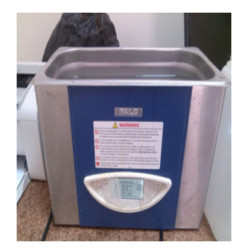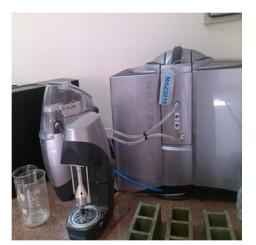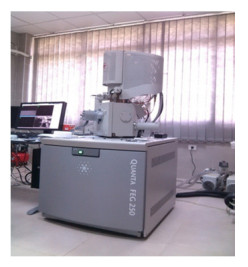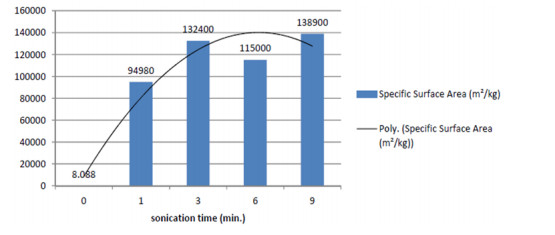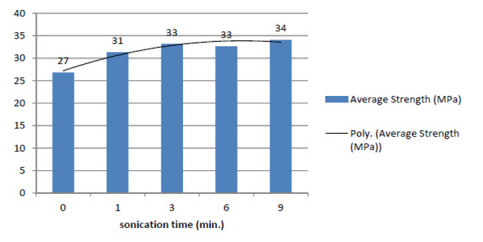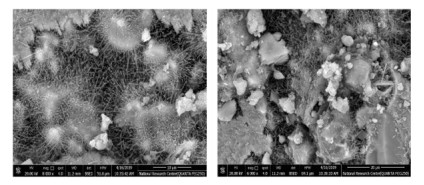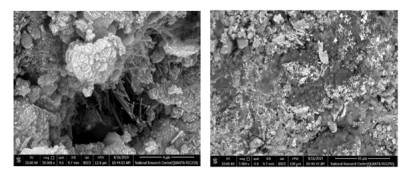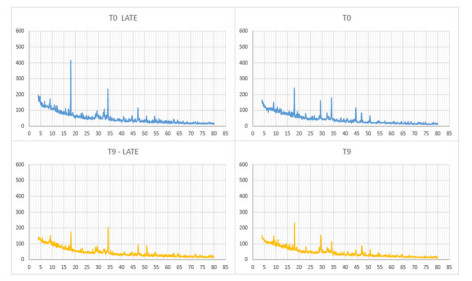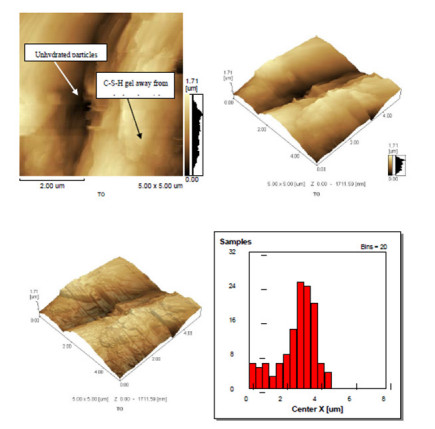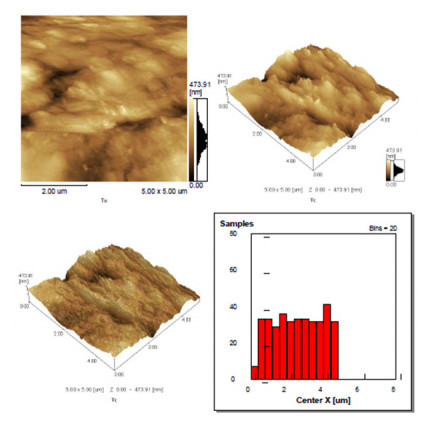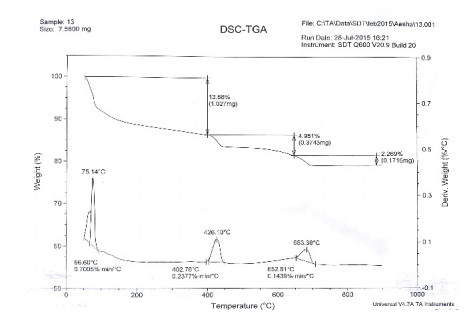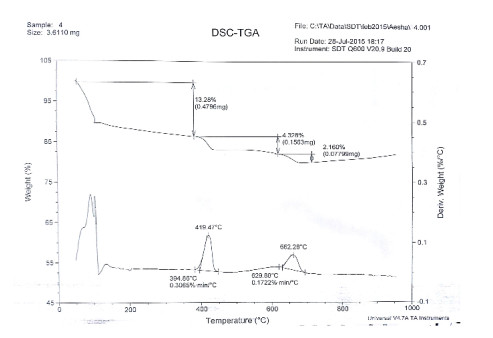Utilizing nanotechnology for the production of nano cement may be considered as an innovative potential approach that can be reached via increasing the specific surface area of cement. Van der Waals forces are the main reason behind the agglomeration of cement particles in concrete. The balance between repulsive and attractive forces of cement particles has a profound effect on concrete properties. The present study focuses on the effect of ultrasonic processing at relatively low frequency on the dispersion of cement particles and investigating the effectiveness of such approach in increasing the sub-nano metric cement content leading to increasing cement reactivity. A qualitative analysis was conducted with a view to investigate the sonication effect on the mechanical properties of cement. In addition micro-structural analyses were conducted to understand the surface morphology and microstructure of cement composites using particle size distribution, scanning electron microscope, Thermo-gravimetric analysis, X-ray diffraction and atomic force microscopy tests. The results of the investigational study showed that the mechanical, and microstructure of cement pastes can be remarkably improved by subjecting the cement slurry to an optimum time of sonication. The proposed method helped in achieving specific surface area of 138900 m2/kg with sub-nano metric cement particles of 80% and gain in compressive strength of about 27%. The microstructural analysis performed revealed that the proposed sonication method had influenced the micro structure of the cement matrix by increasing the reactivity of the cement particles as a result of their transfer to the nano level. Moreover, the microstructural analysis highly confirmed the determined mechanical properties.
1.
Introduction
Concrete is the most commonly utilized construction material and their design consumes nearly the total cement production in the world. The utilization of great quantities of cement produces expanding CO2 emissions. The cement industry has a bad effect on the eco-system, physical, chemical and biological components of the environment. It is one of the most energy consuming industries due to the high amount of CO2 emission, 5% of these emissions are caused by global man-made; 50% by chemical manufacturing and 40% due to burning fuel. Due to these environmental issues, the concrete industry targets to reduce CO2 emissions. New changes are important. Developments in the concrete formulation, to be more efficient, can help if these changes result in concrete with the same performance but with lower cement consumption. In this regard, the enhancement of packing and dispersion of particles increases this efficiency as it has been previously mentioned in the literature [1,2].
Therefore, it is essential to develop alternative binders which are more environmentally friendly and cost-effective. Introducing a new technology to cement manufacturing methods which are consistent with the major principles of sustainability can be a great response to this necessity. Nano technology can help to overcome major environmental challenges through reducing CO2 emissions and producing better quality cement particles as a result of incorporating different types of nano materials such as nano silica particles (SiO2), multi-walled carbon nanotubes composite fibers, and nano clay particles. The nano materials are mainly used to improve most of the mechanical properties of the cementitious materials like; tensile strength and compressive strength, besides, crack and corrosion resistances [3,4,5,6,7,8,9,10,11].
Moreover, utilizing nanotechnology for the production of nano cement may be considered as a potential approach in such regard. This manufacturing technology can be achieved through expanding the specific surface area of cement via increasing the sub-nano-metric cement particles, for example, the particles of size less than 100 nm. Increasing the surface area significantly influenced the chemical reactivity and nucleation effect, thus enhancing the strength and durability of concrete with less quantity of cement [12,13,14,15,16,17].
In the last few years, an increased number of researches have been conducted indicating that nano technology could be a potential alternative to the traditional cement composites production techniques [18,19,20,21,22]. Moreover, there is a technical possibility of applying nano technology in cement production.
The major problem in utilizing nano-particles is that they are highly agglomerated particles which cause a loss in their high-surface-area due to grain growth. Effective de-agglomeration and dispersion for nano-particles are needed to overcome the bonding van der Waals forces after wetting which results in the formation of agglomerations in the form of clumps those are very difficult to de-agglomerate. This phenomenon affects the rheological behavior of the cement composite and the ultimate mechanical hardened properties. Thus, there is a need to increase the repulsive forces between adjacent particles to disperse cement particles in aqueous solution.
The dispersion problem has been combated by methods like using Superplasticizers, which had been widely used in such regard within the cement literature [23,24]. The main effect of these chemical admixtures is to disperse the agglomerated cement particles [25,26,27,28,29]. In addition to the modification of inter-particle forces, superplasticizers likewise influence the progressing chemical reactions in the cement suspension [24,30]. This can also affect the flow properties, and there is a discussion about the general significance of the two systems. This is especially valid for situations where specific combinations of cements and super-plasticizers exhibit particularly poor rheological performance. For the purpose of avoiding these incompatibilities or at least eliminating them, it is important to study enhancing the dispersion without the use of superplasticizers.
However, traditional solid blending advancements give for the most part insufficient blending activity to scatter the agglomerates of concrete particles and different cementitious materials. The issue coming from this is the external particles of such agglomerates are exposed to water, yet the surfaces of the internal particles stay dry. The outcome is moderate and incomplete hydration. Another inventive innovation-the ultrasonic blending of cement composites-offers extraordinary advantages for precast molding, dry-cast and concrete producers. Ultrasonic dispersing is the most trendsetting innovation to de-agglomerate and scatter micron-size and nano-size materials in fluids. For cement, fly ash, silica's, pigments and carbon nanotubes ultrasonic dispersing advances the particle distribution and the contact of the particles with water. Particularly micro- and nano-silica, as well as nanotubes, are utilized to improve the compressive strength of high-performance concrete. Depending on the cavitational shear forces, ultrasonic blending of nano sized particles has proven to be more efficient than conventional rotary mixers and rotor-stator mixers. The following research [31] studied the effect of nano silica de-agglomeration using sonication. The research concluded that the use of 5 min sonication showed a significant effect on de-agglomerating nano silica particles when compared with other methods as well as the specimens showed a significant increase in compressive strength by 23% compared to control sample by adding 1% of sonicated nano silica.
A group of authors had been studied the reactivity of dispersing silica fume particles using indirect sonication. All the process investigations studied showed a significant influence on the decrease of silica fume particles size. The amount of nanometric particles of silica fume increased using indirect sonication to reach 90% of the sample as compared to only 22% of the original silica fume, its mean size reached 57 nm. The TEM micrographs as well as the zeta potential values confirmed the previous behavior. Zeta potential values for the optimum sample reached −35 mv as compared to the original silica fume (−23 mv). For the mechanical testing, significant increase in compressive strength has been observed, as the most desirable sample of prepared nano silica fume enhanced the compressive strength significantly, as by only 1% of cement substitution a gain equivalent to 10% of original silica fume was reached (20% gain) compared to control mix without any cement replacements [32].
This paper presents the investigation of the indirect sonication method to reduce the cement content in concrete mixes with the improvement of cement particles dispersion in water and cement composites, a study that evaluates the suitability of introducing nano technology via the production and preparation of nano cement particles with complete dispersion of these cement particles in order to improve the efficiency, as evaluated by the proportion between binder utilization and compressive strength (the performance parameter used in most practical applications). Moreover, the better dispersion of the cement particles will result in reducing the agglomerated cement particles that entrap a significant part of the mixing water and in turn reducing the workability. The reduced workability will lead to increasing the need of the super-plasticizers to free the entrapped water via their electrostatic and steric performances. In order to achieve the previously mentioned goal, experimental and statistical research plan is to be implemented. The influence of the method and duration of applying indirect sonication energy to disperse cement particles will be studied. Particle size distribution will be introduced to investigate the effect of sonication time on cement particles dispersion. Characterization of the main properties of prepared cement pastes will be investigated using different techniques: scanning electron microscope (SEM), thermo-gravimetric analysis (TGA), X-ray diffraction (XRD), and Atomic force microscopy (AFM) to reach optimum, and most desirable sonication time.
2.
Experimental plan
The experimental test program is designed to achieve the research objectives. The experimental program objective is to provide guidelines for optimizing the dispersion process of cement particles using indirect sonication then study the optimum dispersion time for cement particles in cement composites.
2.1. Characterization of used materials
Ordinary portland cement (OPC) conforming to ASTM C150 standard is to be used as received. The components of the OPC are shown in Table 1.
The water used in the mix design is potable water from the water-supply network system, free from suspended solids and organic materials, which can affect the properties of the fresh and hardened concrete.
2.2. Characterization of used equipment
Bath Sonicator, a modern ultra-sonication bath is used to perform the proposed study, the used bath Sonicator is produced by FALC instruments, Italy, see Figure 1.
A bath sonicator full of water is set to the specified time, 40 KHz frequency and 100% power of sonication. Temperature is set to 20 ℃ and tank temperature does not exceed 40 ℃. The water level should pass the heating level to avoid solution evaporation. In a sonication bath (indirect sonication), the ultrasonic waves must pass through the bath liquid and then the wall of the sample container before reaching the suspension.
2.3. Testing
The fundamental properties of concrete such as strength, ductility, early age rheology, creep and shrinkage, fracture behavior, durability, etc. are affected by material properties at the nano scale. However, the nano and microstructure of the most important hydration product in cement paste, calcium silicate hydrates (C–S–H) is not well understood. In order to improve cement and concrete properties, it is necessary to understand the nano scale properties. In order to evaluate, analyze the results, a number of characterization techniques are to be used.
2.3.1. Particle size distribution
Particle size distribution is an effective method to optimize the optimum dispersion of nano particles in water. Mastersizer 3000 (shown in Figure 2) is used to predict the particles size through the use of Laser light scattering technique. Data acquisition rate is 10 KHz. Its typical measurement time is less than 10 s. Particle size varies from 0.01 to 3500 μm.
2.3.2. Scanning electron microscope (SEM)
Scanning electron microscope (SEM) is used to determine the nano particles size and distribution, characterize the concrete mixtures, and help to interpret the compressive strength results of the samples after 28 d of curing in water. QUANTA FEG250 shown in Figure 3 was used to detect the images. The secondary electron images are to be obtained in samples coated with Au and using a voltage of 20 kV.
2.3.3. X-ray diffraction (XRD)
X-ray diffraction (XRD) is one of the best methods for detecting changes in hydration reaction and products. A mineralogical study is conducted employing the X-ray diffraction technique (XRD) to identify the formed phases before and after exposure to 600 ℃. After performing the compressive strength test, the crushed concrete cubes of each mix are finely ground and totally mixed. A representative sample from each mix is undertaken and ground to a very fine powder that passes (75 lm) sieve and is tested immediately after that.
2.3.4. Thermogravimetric analysis (TGA)
The TGA test is widely used for determining the effect of high temperature on hydrated cement composites. Thermo-gravimetric analysis (TGA) is carried out in a mortar or paste mixes cured in water for 28 d. A TGA850 thermo balance from Mettler Toledo and STARe software v8.10 was used. The samples are previously milled, washed with acetone, filtered and then dried at 60 ± 2 ℃ for approximately 30 min. Aluminum crucibles of 100 mL are used and filled with 30 ± 1 mg of dried sample. Samples are heated up to 1000 ℃ with a heating rate of 10 ℃/min in a nitrogen atmosphere.
2.3.5. Atomic force microscopy (AFM)
AFM is a technique that is capable of both imaging surface structure and recording local mechanical properties of the sample. AFM was used to image nano and microstructure of cement paste after a few hours of hydration and after it is completely hardened. This introduces new possibilities for characterizing the properties of the interfacial transition zone that has a considerable effect on the overall performance of cement-based materials. Hardened cement paste with a water to cement ratio of 0.55 was used in this study. Specimens were cut and polished using silicon carbide paper down then polished to obtain a very smooth surface.
2.3.6. The compressive strength test
The compressive strength test of the concrete samples is determined at 7 and 28 d of moisture curing as per ASTM C39. The test is carried out using a universal testing machine SHIMADZU 1000 KN. The W/C ratio of the specimens cast for compressive strength test was 0.55.
2.4. Samples preparation
The first stage: the objective is to provide guidelines for optimizing the preparation process of cement using indirect sonication to investigate the best time of sonication. 5 samples are prepared by adding 540 gm of cement in a glass beaker to 300 ml of water for each time of sonication. This was then subjected to indirect sonication for 0, 1, 3, 6 and 9 min. Table 2 shows the designation of cement paste samples.
The second stage: 15 paste samples composed of cubes for compressive after 28 d, water curing. Characterization of the main properties of prepared cement pastes will be investigated using different techniques: scanning electron microscope (SEM), thermo-gravimetric analysis (TGA), X-Ray diffraction (XRD) to reach optimum, and most desirable sonication time.
At first, the dry component will be pre-mixed with water in order to form a high concentration cement paste. Then the ultrasonic mixer, de-agglomerates and disperses the cement particles using cavitational shear. Finally, the entire surface of each cement particle will be totally exposed to water.
3.
Results and discussion
In this phase, the effect of sonication time will be studied for the effective dispersion of cement. The dispersion level as well as the sub-nano-metric contents of each sample will be evaluated using particle size distribution curves and the specific surface area of the produced cement.
3.1. The effect of sonication on the dispersion of cement and the sub nano metric content
From the following Figures 4-6, a general observation showed that with the increase in the sonication time, the sub-nano-metric particle content increased to reach an optimum value of 80% after 9 min subjection to indirect sonication instead of only 5% sub nano metric particles for the as-received cement sample. Moreover, increasing the indirect sonication time to 1, 3 and 6 min increased the sub-nano-metric particle contents to 50%, 60%, and 70%, respectively. The optimum time of sonication for the indirect sonication method was found to be 9 min. The optimum specific surface area for 9 min indirect sonication increased to 138900 m2/kg as compared to the as-received cement sample specific surface area which was only 8.08 m2/kg.
Generally, the repulsive forces of sonication helped the particles to repel each other and make the particles collide with each other due to the ultrasonic cavitation. This breaks van der Waals forces in the cement agglomerates and even breaks the primary particles and as such, there will be no tendency for the cement particles to re-agglomerate the case that will result in an expanded particle collision frequency. On a basic level, an increased collision frequency will improve particle breakage due to an increase in particle-particle impact events reducing again their primary size. Moreover, large particles are subject to surface disintegration (by means of cavitation breakdown in the encompassing fluid) or particle measure decrease (because of splitting through between molecule impact and the breakdown of cavitation bubbles shaped on the surface). The impact of time could be ascribed to the way that the agammaegate sum of energy (E) delivered to a suspension relies upon the applied power (P) yet in addition on the agammaegate sum of time (t) that the suspension is subject to the ultrasonic treatment: E = P × t. Subsequently, and since the suspensions were treated at the steady power but for various times, they demonstrated essentially extraordinary scattering and dispersion states.
3.2. Mechanical properties
This stage presented the effect of changing sonication time of cement on the compressive strength of the cement pastes after ultra-sonication subjection. Figure 7 showed the compressive strength for cement pastes sonicated for different times, and the results revealed that by increasing sonication time; the compressive strength of the cement pastes increased remarkably as compared to the control mix. The optimum sonication time was 9 min with gain in compressive strength reached about 27% as compared with the control mix (unsonicated mix). The strength gain reached 17%, 24%, and 22% for sonication times of 1 min, 3 min, and 6 min, respectively. This indicates the efficiency of the proposed treatment in enhancing the reactivity of cement particles by increasing the nano metric particles to more than 80%, and as such, the gain in strength can be credited to the recently referenced impact of sonication particularly at low frequencies and high intensities in de-agglomerating, and dispersing of the nano particles through the cavitational impact that prompted larger number of surface atoms in the nano particles convert into a higher number of free and unsaturated atomic bonds on the surface of the nano particles, which makes them thermodynamically unstable and leads to prompts an expansion in the proper surface area for chemical reactions resulting in a significant increase in the mechanical properties, the condition that will be confirmed through the microstructural analysis sections hereunder.
A remarkable observation from Figure 7 is that the trend of increase in the compressive strength has shown to be less steep after reaching the 3 minutes of sonication and up to the 9 min on contrary to the clear steep inclination of the curve from the control up to the 3 min.
3.3. Microstructure analysis
Based on the previously reported results, the 9 min of cement sonication was chosen as an optimum mix, as compared to the mix prepared with as received cement (control mix), the following microstructural analyses were performed.
SEM Scanning Electron Microscope micrographs of the optimum cement paste sonicated for 9 min as compared to plain cement paste were shown in Figures 8-9. The SEM images were taken to study the major differences in the micro-structure of the nano-cement matrix and the micro-cement matrix. Generally, from the SEM plates, the morphology structure in the control sample, when compared with the sonicated sample, are in great agreement with the compressive strength results, and very indicative to the reactivity of the sub-nano metric cement particles produced by the sonication method. Calcium silicate hydrate plates (C–S–H) as well as the calcium hydroxide crystals (CH) and ettringite needles were clearly identifiable in the control specimen (without sonication) in addition to the porous structure of the paste. On the other hand, in the micrographs of the optimum sonicated specimen (C9), the calcium silicate hydrate plates were clearly dominating with a well compacted, and dense structure without major pores or un-hydrated crystals. Moreover, the calcium hydroxide crystals and the ettringite needles were almost hard to identify as a result of the sonication that contributed to producing higher levels of C–S–H due to the high reactivity of cement particles at the nano scale. The large amount of the produced nano cement particles did not only led to higher C–S–H contents but also acted as nucleating points to bind the hydration products from the larger-scale particles together. This phenomenon may explain the high strength of sonicated specimens over the unsonicated mix. Finally, the introduced micrographs demonstrate that the microstructure of the as-received cement suffers from the agglomeration issue (unstable lumps). These unstable lumps make the cement sample vulnerable against standing the compressive loads, unlike those samples with sonicated cement which clearly explains the compressive strength test results.
XRD results were presented in Figure 10. XRD was performed to detect changes in the hydration products due to the application of sonication on the cement particles. Calcium hydroxide, calcium carbonate peaks can clearly be detected in the XRD diagrams of C9 samples as compared to C0 while amorphous materials such as calcium silicate hydrate cannot be directly detected using this technique. For comparison, the peaks of CH at 2-theta = 18, 29, 34, and 44 and the peaks of calcium carbonate at 2-theta = 37 and 47 have been selected. It can be seen that the sonication of cement increases the C–S–H contents and as a result, decreases the intensity of the CH peaks preventing suitable CH crystal growth, thus the CH crystal to C–S–H gel ratio is decreased. In the case of unsuitable CH crystal growth, no hydration reaction would occur. Moreover, the peaks of calcium carbonate followed the same trend of the CH peaks. The trend of the CH and CC peaks at the early age sample, indicated that the ultrasonic cavitational mixing led to faster growth of C–S–H-phases.
AFM is one of a very high-resolution type scanning probe microscopy, with demonstrated resolution in the order of fractions of a nano meter. The topography of the samples surfaces containing different sub-nano-metric cement particles was investigated using AFM imaging. Distinct images in Figures 11 and 12 representing the AFM images of samples containing as received cement and sonicated cement for 9 min are characterizing the properties of cementitious materials and the structure of the hydration C–S–H gel at the nano scale explaining the differences in mechanical properties through the utilization of imaging technique. The AFM topography images of polished cement paste incorporating sonicated nano cement in Figure 12 demonstrated rounded particles assembled into clumps indicating the C–S–H agammaegated particles, which supports the colloidal circular 3D model of C–S–H, since the spherical features saw in Figures are of comparative size to the particles of the previously recognized shapes in the literature [33]. Besides, the clumps seem to have a generally little number of voids. Taylor et al. [34] helped us to remember Everett's definition of gels as "dispersions in which the attractive interactions between the elements of the disperse phase are so strong that the whole system develops a rigid network structure and, under small stresses, behaves elastically". C–S–H in hydrated sonicated cement paste fits this definition precisely. AFM imaging of the leveled flat surface of hydrating cement paste after subjection to sonication [35,36], demonstrates that the components of the disperse phase resulted in the forming of almost typical agammaegated nano particles of C–S–H. On contrary, the AFM images of the control mix represented in Figure 11 indicated the presence of the CH plates which could be easily identified as with small clumps of the C–S–H particles. The distinction between the two stages is appearing, rough and grainy surface of the CSH contrasted with the smoother surface of the CH region. Moreover, Figure 11 shows 5 μm × 5 μm AFM image of C–S–H gel on the left the topography and on the right the amplitude signal. C–S–H un-hydrated particles were very flat (black spots). Small particles on the surface could be of calcium carbonate that developed due to exposure to atmospheric conditions after polishing.
Finally, the variation in the particles size distribution within the as received cement mix on contrary to the almost equal size of those sonicated nano cement particles highly confirm the effectiveness of the proposed method in the growth of denser equally nano-sized C–S–H particles in a chain-like shape as seen in the SEM micrographs. The average roughness values for the as-received cement, and the sonicated cement were 1.696 and 1.905, respectively. The case that confirms the difference in the mechanical properties of both pastes.
TGA Thermal analysis techniques, for example, thermo-gravimetric investigation (TGA) has been utilized effectively to decide the changes in hydration products for cement pastes after exposure to high temperatures versus time. Various investigations have demonstrated that an increase in temperature in cement pastes results in the release of physically absorbed water, chemically bonded water and the decomposition of hydration products. Figures 13 and 14 represented TGA micrographs of plain cement composite as compared to the mix containing optimum cement paste sonicated for 9 min.
Through the DSC curves, three noteworthy endothermic peaks can be distinguished. The first peak is between 80 and 150 C, which occurs due to the loss of the physically absorbed water from the cement pastes. The second peak, between 400 and 500 C, related to the de-hydroxylation of calcium hydroxide and the loss of some of the chemically bonded water from calcium silicate hydrate. The third peak, between 700 and 800 C, related to the total dehydration of calcium hydroxide, which is likewise supported by the XRD results, and the dehydration of calcium silicate hydrate. Additionally, the DSC curves demonstrate that the specimens with nano cement sonicated particles indicated more stable behavior during the temperature increase contrasted to the control specimens. This phenomenon is most likely due to the high amount of high-density calcium silicate hydrate in these specimens that were not influenced by high-temperature exposure. The loss in weight observed for the control mix from 75 to 430 (18.5%) was higher than the optimum mix C9 (17.5%). This can be attributed to the larger amount of CH in the control mix as compared to the mixes containing sonicated nano cement particles. While the loss in weight determined for the control mix at the third peak was lower than the optimum mix C9 which confirms the presence of much more C–S–H within the sonicated matrix than the as-received cement matrix, the matter that is in good agreement with the compressive strength results as well.
4.
Conclusions
Based upon results presented and discussed in the preceding sections, the following conclusions can be drawn:
● Cement dispersion using indirect sonication significantly enhanced cement pastes properties resulting in transforming the cement particles to the nano size with almost 80% of the particles as the case with 9 min of sonication.
● By increasing sonication time; the compressive strength of the cement pastes increased as compared to the control mix. The optimum time of sonication was found to be 9 min which got a gain in compressive strength by 27%.
● The microstructural analysis performed through SEM, XRD, TGA, and AFM, revealed that the proposed sonication method had influenced the microstructure of the cement matrix by increasing the reactivity of the cement particles as a result of their transfer to the nano level. Moreover, the microstructural analysis highly confirmed the determined mechanical properties.
● Finally, it is highly recommended to expand this study to cover the rheological properties of cement composites, especially after applying the ultra-sonication, and how could that possibly help in reducing the use of chemical dispersants.
Acknowledgments
M.S. El-Feky, M.I. Serag, and Passant Youssef prepared the samples and wrote the main manuscript text and A.M. El-Tair prepared the Figures and Tables. All authors reviewed the manuscript.
Conflict of interests
The authors declare no competing interests.









 DownLoad:
DownLoad:
